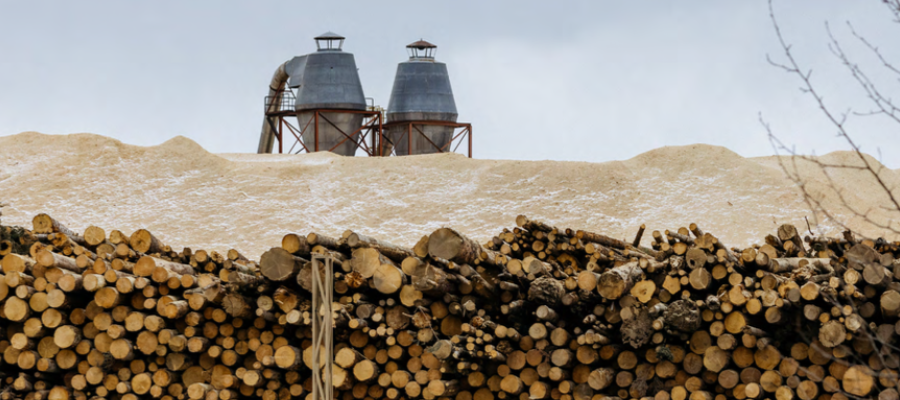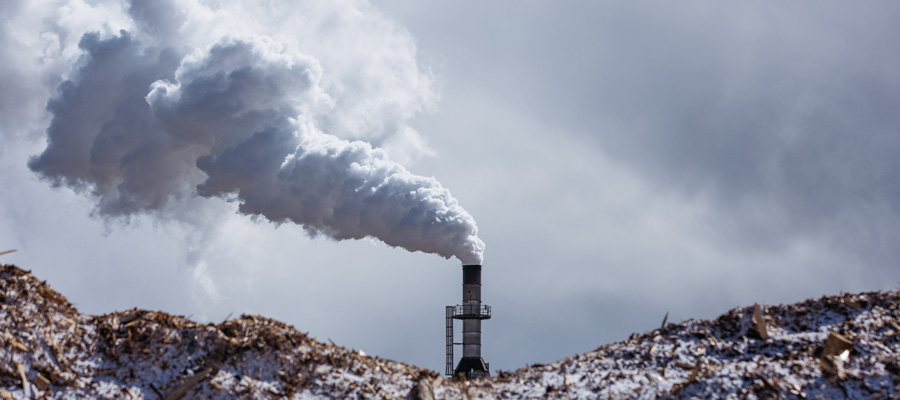As wood pellet exports to Japan surge, BC’s primary forests feel the strain

In the land of the rising sun, the light of a setting sun glints so brightly on the shiny metal piping of Renova’s Ishinomaki Hibarino power plant that you have to shield your eyes.
Located near the city of Sendai, north of Tokyo, the new thermal electricity plant is one of several in Japan that burns biomass to generate electricity, in this case enough to supply 17,000 homes.
Renova’s biomass comes in one of two forms: wood pellets made from felled trees and palm kernel shells, the waste left over after processing palm oil.
On this day, the biomass being amassed for future burning is crushed palm kernel shells that likely originated in Indonesia or Malaysia and are being unloaded one giant orange bucketful at a time from the cavernous hold of the Coral Princess, an ocean freighter anchored nearby.
Every few minutes, a truck laden with the shells arrives at a yard alongside the Renova plant to dump its contents before turning around and returning to the docks for another load.
Similar scenes are playing out up and down Japan’s coast at thermal electricity plants that have sprung up with eye-popping speed following the sudden and profound energy crisis thrust upon the country on March 11, 2011.
An earthquake-induced energy crisis
That day, one of the most powerful earthquakes ever recorded triggered a tsunami that devastated large swaths of Japan’s low-lying Pacific coast killing 20,000 people and destroying or badly damaging critical infrastructure including roads, bridges, rail lines, homes, businesses and power facilities, most notably nuclear reactors like those at Fukushima, also near Sendai.
In the following days and weeks, the Japanese government shut down not just those nuclear plants that were damaged during the epic quake but also temporarily shut down all nuclear power production in the country.
That momentous decision meant close to one-third of the country’s power production was gone, spurring immediate energy conservation measures and soon an effort to rapidly ramp up thermal electricity production, both by burning more conventional fossil fuels such as coal and natural gas as well as burning biomass.
To encourage more of the latter along with other “renewable” power such as solar, the country took a leaf out of the United Kingdom’s playbook and subsidized these new projects with generous feed-in tariffs.
Japan’s rapid development of its bioenergy industry comes, however, at considerable cost to those countries that are supplying the biomass to run the new network of plants. It could be Borneo whose tropical forests have been razed to make way for palm oil plantations, a death knell for orangutans and other endangered wildlife, or the primary and old-growth forests of central British Columbia where fewer and fewer caribou roam.
Late last year I received an invitation to travel and speak in Japan from three environmental organizations as a result of my work as a policy analyst with the Canadian Centre for Policy Alternatives, BC Office on the growth of the wood pellet industry in BC.
A deepening supply crisis
I came away from that 10-day trip which took me to Tokyo and Sendai more convinced than before I travelled there that the surge in wood pellet shipments to Japan and two other countries in particular—the United Kingdom and South Korea—is pushing BC deeper into a timber supply crisis that will have consequences at home and abroad.
Despite this supply crisis, wood pellet exports from Canada more than doubled in the 10 years ending in 2023 with exports from BC representing the majority of those shipments. And Japan accounted for much of that surge.
BC’s forests already show signs of being significantly overcut, which is reflected in rapidly declining logging rates and rising mill closures. Add to that the humbling number of wildfires burning year in and year out with roughly 2.5% of BC’s land base burned last year alone, and you have all the ingredients for a major timber supply crisis—a crisis that both the forest industry and the provincial government are well aware of.
Despite this supply crisis, wood pellet exports from Canada more than doubled in the 10 years ending in 2023 with exports from BC representing the majority of those shipments. And Japan accounted for much of that surge.
A review of export data compiled by Statistics Canada shows that in 2014 slightly under 62,000 tonnes of wood pellets were exported to Japan. By 2023, that figure had exploded to nearly 1.7 million tonnes, with all of those exports from BC. Virtually all of those pellets had their origin in primary forests—those never before subject to industrial logging.
This surge in growth meant that at the end of last year, Japan had a 52% share of Canada’s wood pellet exports and a 76% share of exports from BC. And the demand from Japan continues to rise.
The Drax factor
“The projection is Japan will be needing a million tonnes more by 2027,” says Roger Smith, Japan Director for Mighty Earth. “This is the growth market, not the UK or Europe.”
The company responsible for producing and selling the lion’s share of Canadian-made wood pellets to Japan is Drax, the UK-based company that has been a magnet for critical coverage from climate scientists, the media and non-governmental organizations.
The company operates a massive thermal electricity plant in North Yorkshire, England that burns approximately 6.5 million tonnes of wood pellets annually. This generates more than 12 million tons of CO2 emissions per year, making Drax’s power plant the single-largest point source of greenhouse gas emissions in the United Kingdom.
Both the company and the UK government, which heavily subsidizes Drax, say those emissions don’t count because eventually all the CO2 released from burning that wood is “offset” as newly planted trees sequester atmospheric carbon.
It’s an assertion dismissed by numerous scientists who argue that burning wood actually generates more CO2 emissions than burning coal and that emissions associated with burning wood are not quickly or effectively countered by planting more trees.
Drax has also drawn critical coverage at home and abroad for the impact its operations have on forests in North America, including primary forests in Canada.
Old-growth trees fall to make pellets
In October 2022, BBC’s investigative news show Panorama aired a highly watched documentary based on fieldwork done in BC earlier that year. A documentary crew for CBC’s flagship investigative news show The Fifth Estate also did fieldwork in the province that summer, airing its documentary the same week as its British counterpart.
Drax owns outright or is a partner in numerous mills in BC and Alberta that produce wood pellets, giving it control of roughly 80% of pellet production in both provinces.
Both the BBC and CBC raised significant challenges to Drax’s assertions that it uses primarily wood waste generated at sawmills to make its wood pellets, noting the large number of logs that are trucked to Drax facilities where they are turned directly into the pellets the company then exports to its UK plant and more recently to Japan and South Korea.
Drax is taking logs from old-growth forests in north central BC that were clear-cut by timber companies and delivering those logs directly to its pellet operations in the province.
And challenges continue.
This February, Joe Crowley reported for BBC Panorama that Drax is taking logs from old-growth forests in north central BC that were clear-cut by timber companies and delivering those logs directly to its pellet operations in the province. Crowley’s report noted one instance in which 130 truckloads of logs were delivered, including logs from an old-growth forest that had been identified as a candidate for logging deferrals because of its high ecological values.
Such reporting is not going unnoticed in Japan where environmental organizations have used it effectively to push bioenergy producers and the companies financing them to reassess their wood procurement policies.
Shakeup coming from the financial sector?
This month (April 2024), Japan’s SMBC Financial Group, one of the country’s three largest banks, updated its sustainability policy to address the rising use of woody biomass in energy production.
The change in policy came as a direct result of environmental organizations challenging Japanese financiers over the high carbon emissions and harm to forests and biodiversity associated with Japan’s imports of biomass.
The updated policy will not support new biomass projects in the country that uses fuel that is derived from primary forests. The new policy specifically defines allowable biomass as “wood that is not derived from virgin forests, including unused wood and sawmill residues, and that can be verified as not violating human rights of local residents.”
If such policies become more widespread, they could have significant consequences both for Japan as it seeks to expand its bioenergy ambitions and for Canada and BC, whose primary forests continue to shrink in the face of skyrocketing biomass demand.
Given rising concerns over the fate of primary forests at home and abroad, it is long past due for the BC government to make fundamental reforms to forest policy.
A new roadmap
Here are six recommendations to help increase confidence both in Japan and in BC that forests are not being cut down just so the trees can then be burned.
- Dramatically increase protection of old-growth and primary forests as the provincial government was advised to do by professional foresters and biologists it appointed to guide forest policy. The province continues to consult with First Nations on those recommendations.
- Zone the province’s forests and existing plantations into three broad categories: fully conserved primary forests; forests and plantations managed specifically to enhance key “non-timber” resources such as water and wildlife; and lastly a portion of previously logged lands to be managed for timber production and forest products, but with ecological guidelines that must be met.
- Require by law that all timber processors, including wood pellet mills, submit annual reports detailing all the wood used at their facilities, with a clear, verifiable breakdown of what form that wood takes.
- Strictly prohibit pellet mills from converting trees logged in primary or old-growth forests directly into wood pellets, and require that pellet producers only use the residual waste from sawmills, verifiable wood waste from logging sites, or thinnings from tree plantations as sources of raw material for pellet production.
- Apply the carbon tax to all emissions associated with logs or wood waste currently burned as “slash” at logging operations. This will act as an incentive to either leave such wood unburned at logging sites or to bring it to mill towns where it could be used to make a range of forest products, including but not limited to wood pellets.
- Enact a solid-wood-first strategy and penalize all companies that convert logs or portions of logs to wood pellets that could instead be used to make other forest products.
In the absence of such fundamental reforms, BC is likely to slip further into a deepening timber supply crisis that the government and forest industry both know is well underway and Japan’s bioenergy producers will be left to turn somewhere else for their wood.
This piece is a summary version of the report, Log it and Burn it: Wood pellets, climate and British Columbia’s deepening forest crisis by Ben Parfitt. You can download and read the full report at policyalternatives.ca/pellets
Topics: Climate change & energy policy, Environment, resources & sustainability

